From the Files of the Baxter Building comes Multiversity’s monthly deep dive into the comics and characters that inhabit the world of the First Family of superhero comics: The Fantastic Four!
This month: We find out exactly what the Future Foundation has been up to, we meet the new, evil Fantastic Four, and learn about the history of the Molecule Man!
Please note: there will be major spoilers for both “Marvel Two-in-One” #9 and “Fantastic Four” #2 throughout this article.
While last month’s “Fantastic Four” #1 was the start of the brand new series, it felt more like a zero issue, catching us up on exactly what Ben and Johnny were up to before the FF returned. Here in issue #2, we get exactly the same thing, but with Reed, Sue and the Future Foundation. The Fantastic Four of the title are yet to fully make a comeback, and while the final pages do bring the whole team back together (and it’s a bigger reunion than we expect), this is still not quite the book fans are potentially looking for.
Perhaps that’s a little too harsh. It’s certainly not a bad issue, and Dan Slott cannot hope to write a new “Fantastic Four” series without addressing where they’ve been for the last 3 years. But when you’ve got a company like Marvel that produces mini-series at the drop of a hat which pave the way for brand new ongoings, it’s strange that a similar approach wasn’t adopted here. “Phoenix Resurrection: The Return of Jean Grey” did this just last year, and we’re days away from seeing “The Return of Wolverine,” so quite why these issues weren’t in a “Return of the Fantastic Four” miniseries remains a mystery. Maybe they didn’t feel that the audience would be there, or that the impact of a new “Fantastic Four” #1 would be diminished.
On the other hand, they already have a book that’s primed and perfect for this story: “Marvel Two-in-One.” I remarked last week just how essential that book has been in fleshing out the character development of both Ben Grimm and Johnny Storm in the absence of the rest of the FF, so much so that “Fantastic Four” #1 felt like another issue of “Two-in-One,” so why not make that a more important part of the FF canon and have this story unfold there?
Taking all of this into account, does it diminish the enjoyment of “Fantastic Four” #2 in anyway? Not really. Putting aside the fact that we’re two issues into a run and have yet to see the full potential of the titular team, it’s been fascinating to finally discover just what Reed, Sue, Franklin, Valeria and the Future Foundation have been up to. Perhaps unsurprisingly, it’s exactly what they said they were going to do at the end of “Secret Wars:” restore the multiverse, one universe at a time, exploring as they go.
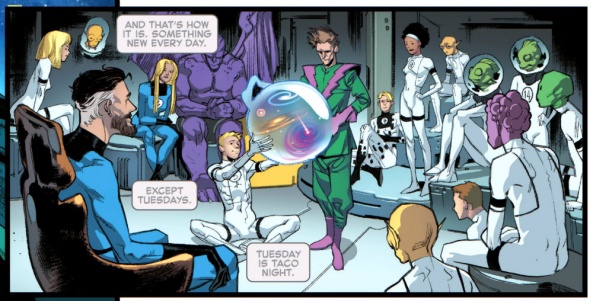
It’s not fully explained whether the multiverse is completely restored at the end of “Secret Wars,” and if Franklin’s new universes are just fun additions, or if his method of making up universes on the spot (this one is an aquatic universe, this one has helium-filled whales, etc) is the multiverse. Either way, we join them on their journey for a little while, discovering that Reed and Sue think of their life now as their “happily ever after.” Which is sweet, if not a little ‘foreshadowy’ in the same way that a photo of a police officer’s family is, just before he gets fatally shot (“he was two days away from retirement!”)
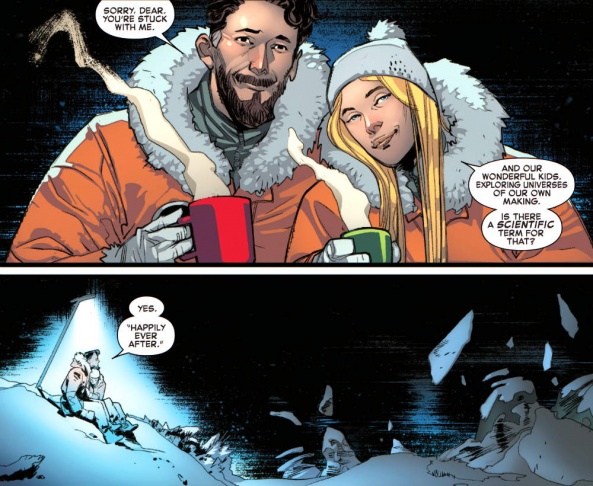
Franklin and Val are much older now, illustrating that time has passed differently for them out in the cosmos, seemingly much faster than it has on Earth. Franklin is a gangly, awkward teen, and Val is old enough to be interested in boys, which makes things doubly awkward for everyone involved, including us.
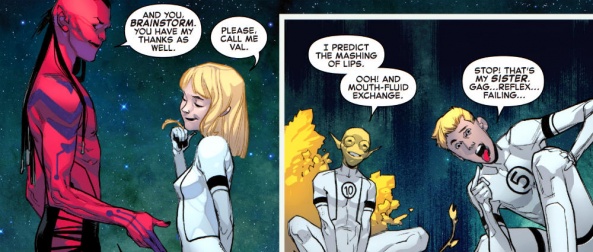
We briefly catch up with some of the Future Foundation, although all of them are seen in Pichelli’s art, including Molecule Man who, I have to admit, had completely slipped my mind. He joined them at the end of “Secret Wars” as the guy that helps anchor all of Franklin’s new universes to the multiverse. It’s not mentioned here, but in “Secret Wars” it’s revealed that Molecule Man places a duplicate of himself into each new universe, and he acts as a sort of constant throughout the multiverse, the one thing that joins all universes together. So he’s pretty essential to Franklin and Reed’s plans.
Continued belowIt’s at this point, however, that we discover just why we’re joining them in their happily ever after. As they are about to leave their latest world, Franklin realizes that his powers have diminished. He’s still a powerhouse (in fact that’s his new nickname, along with Valeria’s Brainstorm), and he’s still more powerful than Hulk, Thor or the Silver Surfer, however, his ability to create new universes with his mind is simply done.
This shift in their circumstances is seen as the perfect time for a brand new enemy to attack. The Griever at the End of All Things arrives and declares that it’s her job to restore the balance of the multiverse. She is entropy and death, and while it’s not explicit in her monologues, I imagine it’s hard to mourn the end of things when there’s a being out there creating life on a scale previously unheard of. Now that Franklin can’t create a new universe every day, The Griever is here to not only undo everything he’s done but end the Fantastic Four as well, as punishment for their hubris.

Anyone that willingly goes around calling themselves ‘Fantastic’ is due a little hubris-trim in my opinion, but nevertheless, the family of heroes goes about trying to thwart someone who is essentially a god. Reed does this by playing one of the oldest tricks in the book: appeal to the villain’s ego. “These are merely children” Reed proclaims, “you’ve not actually defeated the Fantastic Four.” Instead of just shrugging and ending them there and then anyway, Griever grants Reed the ability to summon the rest of his team so that she can defeat them fair and square. So he does just that, he assembles the Fantastic Four. Rather, he summons everyone who’s ever been a member of the FF, which at this point amounts to over 20 Marvel heroes.
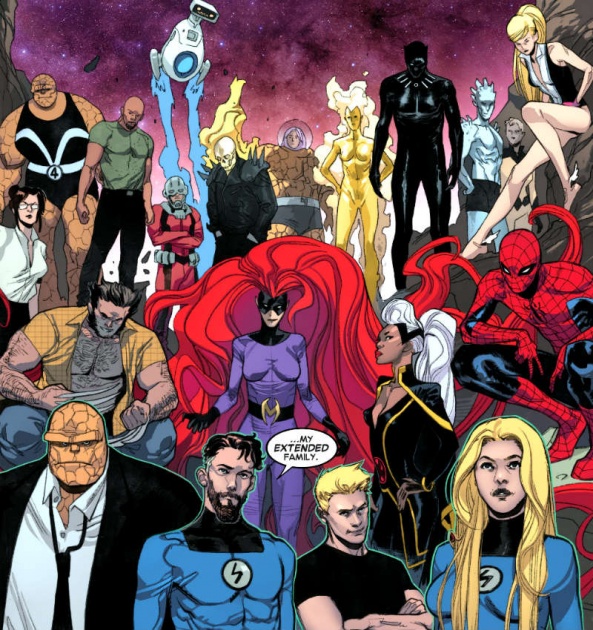
Strangely, neither Hulk or She-Hulk are there, even though both have been on the team at one point or another (they are however both on the cover of issue #3), but Wolverine is there. Presumably Reed hasn’t been told that yes, Marvel technically brought Logan back to life a year ago but they haven’t actually released the official “Return of Wolverine” event yet, so yeah…awkward.
Either way, it’s good to be reminded that this is a family that has a lot of friends and was, at one point in time, a central, foundational part of the Marvel Universe. Oh, and H.E.R.B.I.E’s there as well, proving that Slott knows a legend when he sees one.

Over in “Marvel Two-in-One,” the Fantastic Four are back together! Ok, not really. It’s actually a team of villains brought together by the Mad Thinker to fill the void in the universe left by Reed and his family. Johnny asks the important question:
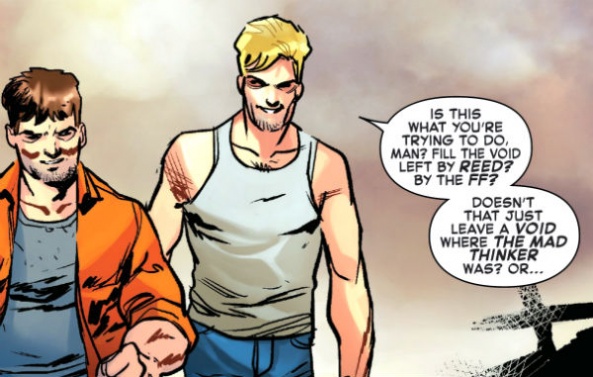
Before he and Ben do what they do best and kick their behinds. What’s great about Chip Zdarsky’s work on “Two-in-One” is that he’s not just throwing these two characters into fun adventures that merely tread water until the full team return, he’s actually providing meaningful character development that not only matures both Ben and Johnny in ways that others have failed but shows us how far they’ve come since we last saw them on the FF.
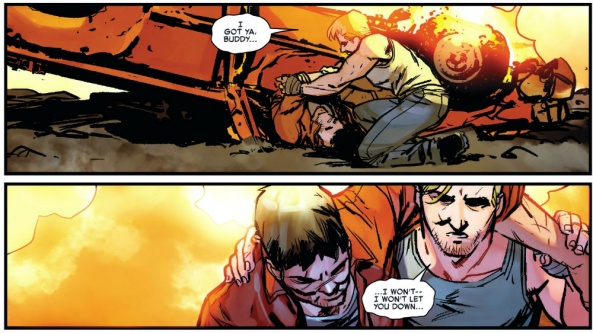
They’ve lost their powers in this universe, but that doesn’t stop them from using everything that they’ve learned over the years to provide a thorough and efficient beatdown to supervillains that outnumber them two to one. It’s pretty great, and I can only hope this kind of insight continues even when the Fantastic Four are inevitably back together. Not to be outdone by “Fantastic Four” #2, Zdarsky arranges a little FF reunion of his own on the final page of “Two-in-One,” although I have a feeling there’s more to it than meets the eye…

One thing I neglected to mention that happened in “Fantastic Four” #2 was the unfortunate death of Owen Reece, aka Molecule Man. There seemingly had to be a casualty of The Griever in order to demonstrate her immense power, and Slott wouldn’t want to kill one of the Future Foundation kids so early in his run, so Owen had to go.
Continued below
He’s had a long and storied history with the team, though, first appearing in “Fantastic Four” #20 from 1963. He was originally a villain that could alter the molecules of his environment to suit his whim, following an industrial accident in the workplace left him with gnarly scars and a whole new skill set.
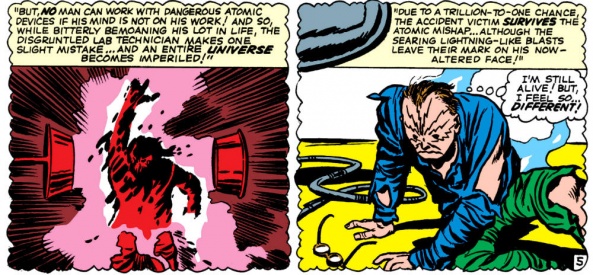
It’s worth noting that the common understanding of Molecule Man is that he got steadily more powerful as the years went by, playing prominent roles in both 1985’s “Secret Wars” and its 2015 counterpart, right down to this latest issue of “Fantastic Four” in fact, where he’s creating whole universes with Franklin and Reed. What’s forgotten, however, is that in his original outing, the FF are alerted to the dangers of this new threat by none other than The Watcher, who breaks his non-interference agreement (for like the hundredth time) to let the family know that this new being is a terrible threat to the universe.
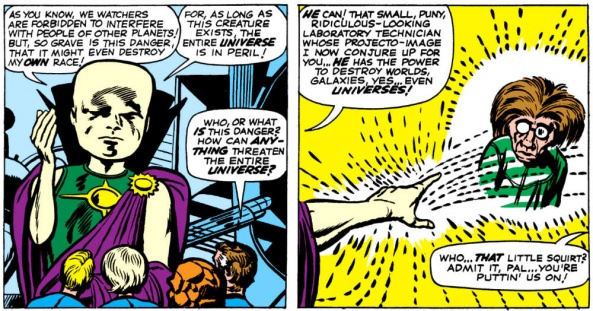
It takes the Fantastic Four a long time of basically trial and error to bring the Molecule Man to justice, as he basically changes the world around them constantly so they can’t get the upper hand on him.

Eventually he’s caught by the foe of every good villain; the diminishing page count. It really feels like Stan Lee ran out of pages, knew he had to wrap this up, so concocted a half-assed idea that involved covering the FF in wet plaster, so that the Molecule Man wouldn’t suspect they were the real thing, then jump out and surprise him when his powers fritzed out?

Either way, it’s an inauspicious end for Owen’s first adventure, and a healthy reminder that the Molecule Man was always a significant threat to the universe. If I wanted to go for the fabled No Prize (i.e. coming up with an in-universe reason for a continuity inconsistency) I’d say that Molecule Man was only treated more and more like the reality altering threat that he is over the years because it took years for his small human brain to fully comprehend just how powerful he truly is. If someone gave you the power to alter every molecule in the universe, you’d probably start out relatively small too.
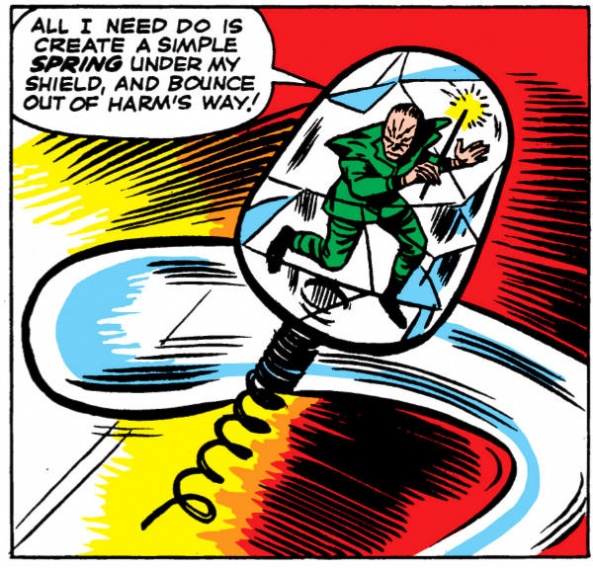
Join me next time, where I’ll be discussing “Fantastic Four” #3 and “Marvel Two-in-One” #10!






